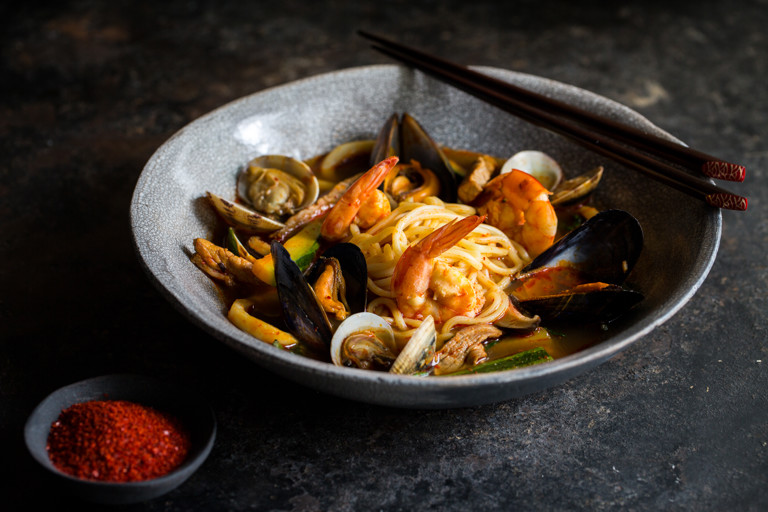Jjamppong (Korean spicy seafood noodle soup)
The key to this stunning jjamppong recipe lies in the intense broth, which is rich with gochugaru chilli flakes for a wonderful depth of flavour. Use whatever combination of seafood and vegetables you prefer for this wonderful Korean dish.
Jjamppong is a popular Korean dish, said to have been originally created by Chinese immigrants living in the Japanese port of Nagasaki. The word ‘Jjamppong’ comes from the Japanese word for mix, which explains why there are quite a few variations of this dish. It is usually based on a varied assortment of seafood with noodles and vegetables, but can also include pork.
The key to this dish is the fiery red soup base created with smokey Korean chilli flakes called gochugaru. For an authentic taste, is not advisable to substitute gochugaru for regular chilli. Two tablespoons may seem like a lot to use in this recipe, but gochugaru is actually relatively mild in comparison to regular chilli powder. Easily and inexpensively available online, these smoky chilli flakes are regularly used in Korean cuisine to make many dishes, including Kimchi, Bulgogi and Tteokbokki. You can also use an leftover gochugaru as a seasoning to add to dipping sauces and marinades and as a spicy rub for roast meat.
I love the combination of mussels, clams, squid and prawns, but as the name of the dish suggests, feel free to change the shellfish according to preference and availability. You can also omit the pork if you prefer and add a few more vegetables. The dried shiitake mushrooms do need pre-soaking for a couple of hours beforehand, but otherwise the recipe is quick to prepare. Why not serve this impressive, yet easy, dinner party worthy dish alongside Japchae, Bibimbap or Bulgogi with a side of Kimchi, for a hearty Korean feast.
Ingredients
Metric
Imperial
Jjamppong
- 5 tbsp of groundnut oil
- 2 tbsp of gochugaru, (Korean chilli flakes)
- 1 garlic clove, peeled and crushed
- 1 knob of ginger, 5cm in length, peeled and finely grated
- 160g of pork fillet, cut into thin strips (optional)
- 3 spring onions, finely chopped
- 1 courgette, small, trimmed and cut into strips
- 100g of white cabbage, thinly sliced
- 5 dried shiitake mushrooms, soaked in 250ml boiling water for 2 hours
- 250g of clams, fresh, cleaned
- 12 prawns, large, head removed and peeled with tail left on
- 250g of mussels, cleaned
- 150g of squid, cleaned and sliced into rings
- 750ml of chicken stock, hot, mixed with 250ml of the reserved shiitake soaking liquid
- 2 tbsp of soy sauce
- 2 tbsp of mirin
- 30g of baby spinach, washed with stalks removed
- 800g of noodles, Korean or ramen
Method
Get in touch
Please sign in or register to send a comment to Great British Chefs.


